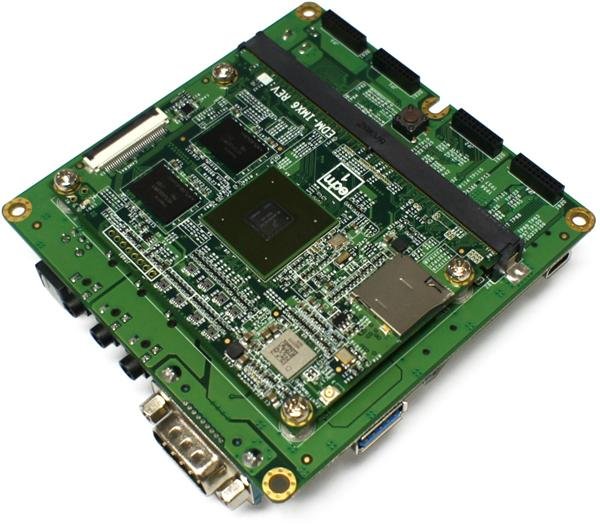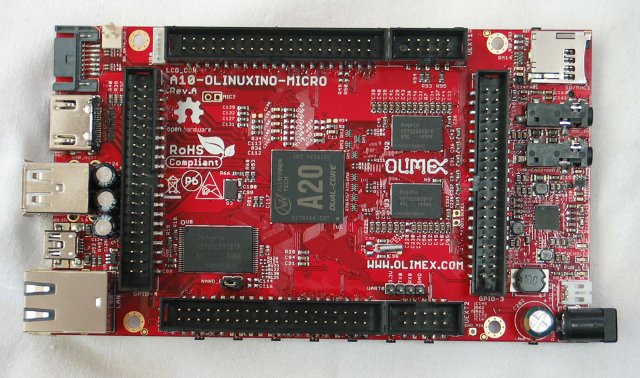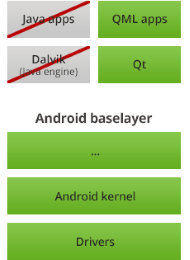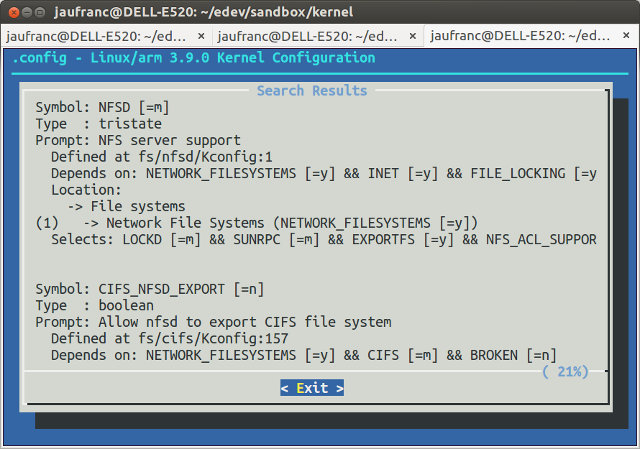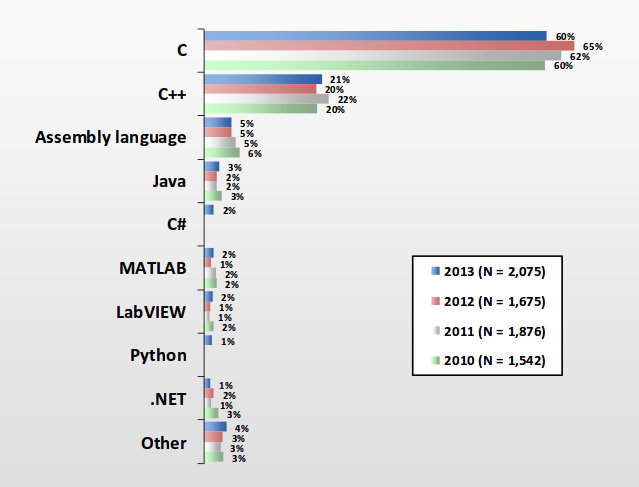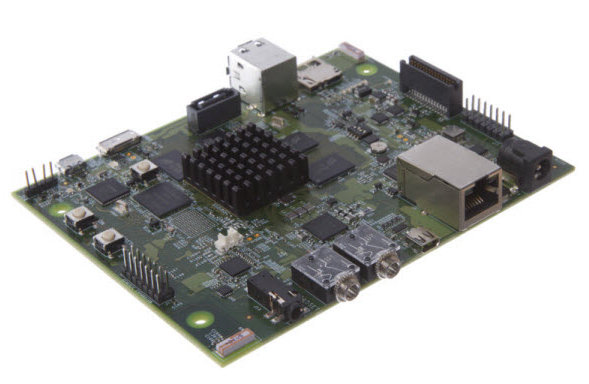XBMC now works pretty well on several Android set-top boxes, but if XBMC is the only application you’re going to run on your device, you may prefer running XBMC in Linux to gain a bit in terms of performance. The only catch is that it’s not available yet, but J1nx posted a teaser video showing XBMC running in Geniatech ATV1200 set-top box. The demo above outputs at 720p, hardware video decoding appears to be working, the user interface is rendered at 30fps with a video played in the background, and CPU usage is about 10 to 20%. Under the hood, the box is running Linux 3.0.50, with Linaro 2013.02 armhf rootfs and BusyBox 1.21. An image is not available yet, and there’s no ETA. Jean-Luc Aufranc (CNXSoft)Jean-Luc started CNX Software in 2010 as a part-time endeavor, before quitting his job as a software engineering manager, and starting to write daily […]
$129 Wandboard Quad Board With Freescale i.MX 6Quad and 2GB RAM
When Wandboard launches their Wandboard Solo and Wandboard Dual boards, many people asked when there would be a quad core version. At the time, the company said they had no plan for a quad core version to keep costs low. If we are to believe a Wandboard Quad listing on mouser.com, they must have changed their mind of they now offer a Freescale i.MX6 Quad version with 2GB RAM, and SATA support, which will sell for $129 (as shown on Wandboard site) or $139 (mouser.com) once it becomes available. The Specifications are very similar to Wandboard Dual, except for the quad core processor, 2GB RAM, and working SATA connector: SoC – Freescale i.MX 6Quad quad core Cortex A9 processor @ 1.2 GHz + Vivante GC2000 GPU System Memory – 2GB RAM Storage – 2x micro SD card slot + SATA connector Video Output – HDMI Audio I/O – HDMI, S/PDIF […]
Olimex A20-OLinuXino Prototype, AllWinner A20 SoM In The Work
Yesterday, Olimex showed their new A20-OLinuXino board. This AllWinner A20 board is still a prototype, and there are currently 3 of them only, but the good news is that it appears to be working, 50 developer edition boards will be manufactured shortly, and mass production should start in June. AllWinner A20 dual core Cortex A7 can clearly be seen in the middle of the board, but if you look close to the top left, you’ll see a marking: “A10-OLINUXINO-MICRO”. That’s because, as planned, they managed to design one PCB for both AllWinner A10 and A20 processors, and they’ll sell both versions. Olimex A10/A20-Olinuxino boards have the followings specifications: SoC – AllWinner A10 Cortex A8 processor or AllWinner A20 dual core Cortex A7 processor, both running @1Ghz System Memory – 512MB or 1GB DDR3 memory depending on model Storage – 4GB NAND Flash (optional), 2x microSD card slot, and SATA connector […]
Digia Brings Qt to Embedded Android Devices with Boot to Qt
Digia has recently announced Boot to Qt Technology Preview, a commercial offering that provides a solution for the creation of user interfaces on embedded systems. For the first version, they stripped out Android of Java, or other unnecessary parts (Zygote, SurfaceFlinger), added Qt/QML, and tested it on on ARM and x86 hardware. Boot to Qt includes the following main features: A light-weight UI stack for embedded Linux, based on the Qt Framework – Boot to Qt is built on an Android kernel/baselayer and offers an elegant means of developing beautiful and performant embedded devices. Ready-made images – We have images for several different devices which include the Boot to Qt software stack, making it possible to get up and running with minimal effort from day one. Full Qt Creator Integration – One-click deploy and run on hardware and a fully featured development environment. Simulator – A VirtualBox based simulator which allows device development […]
How to Find Configuration Options Quickly in Make Menuconfig
If you’ve ever compiled the Linux kernel, you’ll know make menuconfig is the command line used to unset/set options, disable/enable modules in order to match your hardware and requirements. I used to simply browse in the menu to find the option, and just remember the correct path. Sometimes I just looked at .config to locate the option I needed, and the possible path in make menuconfig. The first time you use a new option it can be time consuming. But I’ve just found there is a better way via Google+. “/” is actually available in make menuconfig, just like it is in vi/vim. If you want to enable NFS server in your kernel, press “/”, and search for NFSD. It will show the list of results with “NFSD” strings. NFS server support is right at the top, and the path is shown to be File Systems->Network File Systems. The neat […]
Pidora 18 (Raspberry Pi Fedora Remix 18) Released
John Chiappetta, working for Seneca Centre for Development of Open Technology, has recently announced the release of Raspberry Pi Fedora Remix 18, which will be now known as Pidora 18. If you were there at the time of Raspberry Pi Fedora Remix 14 release, the first ever Linux distribution released for the Raspberry Pi, you may remember it had many issues, and the Raspberry Pi foundation decided to remove it from their Download page. This fourth release will hopefully fix many issues, and they’ll end up back on Raspberry Pi site. Based on the Changelog vs R-Pi Fedora Remix 17, Pidora 18 features look promising: Almost all of the Fedora 18 package set available via yum (thousands of packages were built from the official Fedora repository and made available online) Compiled specifically to take advantage of the hardware already built into the Raspberry Pi Graphical firstboot configuration (with additional modules […]
2013 Embedded Market Study – Software Development & Processors
UBM releases a study of the embedded market every year, by surveying over 1,000 embedded professional every year. They’ve just published their 2013 Embedded Market Study (85 pages report), after surveying over 2,000 engineers and managers, so let’s see whether anything has evolved in the software development and processor space compared to 2012. Again this year, most respondents are based in the US (62%), followed by Europe (20%), and Asia (12%). C/C++ languages still rule the embedded world with 81% market share, although a little less than last year (85%), assembler is a distant third (5%). Interestingly, the average size of development teams seems to have shrunk from 15.9 in 2012 to 14.6 in 2013, the average project being composed of 4 software engineers, 2.9 hardware engineers, 2.7 firmware engineers, 2 QA/Test engineers, 1.5 system integrators, and 1.5 with other functions. About a third of project last less than 6 […]
$329 Texas Instruments OMAP5432 EVM / Development Board
Earlier this month, Texas Instruments has apparently discreetly, not to say surreptitiously, launched their OMAP5432 evaluation module. Beside the dual Cortex A15, dual Cortex M4 OMAP5 SoC, the board comes with 2GB RAM, a 4GB eMMC module, USB 3.0, SATA and more. OMAP5432 EVM Specifications: SoC – Texas Instruments OMAP5432 Multicore ARM Cortex A15/M4 processor with PowerVR SGX544MP2 GPU System Memory – 2GB DDR3L (implemented using 4x Micron 4Gb DDR3L devices (MT41K256M16HA-125:E) Storage – 4GB EMMC/iNAND Ultra device + SD/MMC 4-bit Micro-SD card cage Display / Video: HDMI via native OMAP HDMI interface DSI Display Expansion (DSIPORTA and DSIPORTC) via 100-pin expansion connector Parallel Display Expansion (DPI) via 100-pin expansion connector Audio – Audio Jack 3.5mm, Stereo out & in, Headset Jack (earphone/microphone) USB – 3x USB HS 2.0 (2 via USB connector, one via 0.1″ header), 1x USB 3.0, and 1x USB OTG 2.0/3.0 Connectivity – 10/100 802.3u Ethernet. […]



